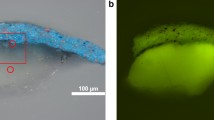Abstract
The potential of attenuated total reflection Fourier transform infrared (ATR-FTIR) imaging for the characterisation of the chemical components of paint cross sections from old master paintings was investigated. Three cross sections were chosen to cover a variety of the analytical problems encountered in samples from paintings. The binding medium and degradation products in a green paint sample from a fifteenth-century Florentine painting were imaged, as well as a thin layer within a cross-section from a fifteenth-century German painting, and multiple thin surface coatings on a painting of the 1760s by Peter Romney. The application of chemometric methods for further analysis of the large data set generated for each sample was also explored. The study demonstrated the advantages of ATR-FTIR imaging, which allowed images to be obtained with high spatial resolution (ca. 3–4 μm) without the need to microtome the sample. The gain in sensitivity in detecting trace materials and the information derived from the location of these compounds in the sample was especially valuable, improving interpretation of the FTIR analysis and extending knowledge of the sample composition beyond that obtainable with other analytical techniques.







Similar content being viewed by others
References
Pilc J, White R (1995) Natl Gallery Tech Bull 16:73–84
Ricci C, Miliani C, Brunetti BG, Sgamellotti A (2006) Talanta 69:1221–1226
Bitossi G, Giorgi R, Mauro M, Salvadori B, Dei L (2005) Appl Spectrosc Rev 40:187–228
Koenig JL, Bobiak JP (2007) Macromol Mater Eng 292:801–816
Gupper A, Wilhelm P, Schmied M, Kazarian SG, Chan KLA, Reussner J (2002) Appl Spectrosc 56:1515–1523
Chan KLA, Kazarian SG (2006) Lab Chip 6:864–870
Ricci C, Bleay S, Kazarian SG (2007) Anal Chem 79:5771–5776
Kazarian SG, Chan KLA (2006) Biochim Biophys Acta Biomembr 1758:858–867
Lewis EN, Treado PJ, Reeder RC, Story GM, Dowrey AE, Marcott C, Levin IW (1995) Anal Chem 67:3377–3381
Van der Weerd J, Brammer H, Boon JJ, Heeren RMA (2002) Appl Spectrosc 56:275–283
Ricci C, Bloxham S, Kazarian SG (2007) J Cult Herit 8:387–395
The National Gallery, London (2008) The Virgin and Child with Two Angels. http://www.nationalgallery.org.uk/cgi-bin/WebObjects.dll/CollectionPublisher.woa/wa/work?workNumber=NG2508. Accessed 14 Apr 2008
The National Gallery, London (2008) The Conversion of Saint Hubert. http://www.nationalgallery.org.uk/cgi-bin/WebObjects.dll/CollectionPublisher.woa/wa/work?workNumber=ng252. Accessed 14 Apr 2008
Penketh S (ed) (1995) Concise illustrated catalogue of British paintings in the Walker Art Gallery and at Sudley, National Museums and Galleries on Merseyside, Liverpool, p 46
Burka EM, Curbelo R (2000) ATR imaging spectrometer. US Patent 6,141,100
Higgitt C, White R (2005) Natl Gallery Tech Bull 26:88–104
Parker FS (1975) Appl Spectrosc 29:129–147
Goldsmith JA, Ross SD (1968) Spectrochim Acta 24A:2131–2137
Kühn H (1993) Malachite and green verditer. In: Roy A (ed) Artists’ pigments. A handbook of their history and characteristics 2. National Gallery of Art, Washington, pp 183–202
Robinet L, Corbeil M-C (2003) Stud Conserv 48:23–40
Gunn M, Chottard G, Rivière E, Girerd J-J, Chottard J-C (2002) Stud Conserv 47:12–23
Frost RL, Martens WN, Mahmutagic E, Kloprogge JT (2002) J Raman Spectrosc 33:252–259
Frost RL, Martens WN, Kloprogge JT, Williams P (2003) J Raman Spectrosc 34:145–151
Dunn PJ, Gobel V, Grice JD, Puziewicz J, Shigley JE, Vanko DA, Zilczer J (1985) Am Mineral 70:436–441
Anthony JW, Bideaux RA, Biadh KW, Nichols MC (1990) Handbook of mineralogy. www.handbookofmineralogy.org. Accessed 14 Apr 2008
Mills JS, White R (1994) The organic chemistry of museum objects, 2nd edn. Butterworths, London, p 42
Goltz D, McClelland J, Schellenberg A, Attas M, Cloutis E, Collins C (2003) Appl Spectrosc 57:1393–1398
Keune K, Boon JJ (2007) Stud Conserv 52:161–176
Berrie BH (1997) Prussian blue. In: West Fitzhugh E (ed) Artists’ pigments. A handbook of their history and characteristics 3. National Gallery of Art, Washington, pp 191–218
Acknowledgements
CR and SGK would like to thank EPSRC for support (Grant EP/C532678/1). MS and DAP would like to thank Dr. Catherine Higgitt (British Museum) for useful discussions and for the FTIR microscopy results on paint films of red lead and lead-tin yellow in egg tempera, and Dr. Janet Ambers (British Museum) for the Raman microscopy.
Author information
Authors and Affiliations
Corresponding author
Rights and permissions
About this article
Cite this article
Spring, M., Ricci, C., Peggie, D.A. et al. ATR-FTIR imaging for the analysis of organic materials in paint cross sections: case studies on paint samples from the National Gallery, London. Anal Bioanal Chem 392, 37–45 (2008). https://doi.org/10.1007/s00216-008-2092-y
Received:
Revised:
Accepted:
Published:
Issue Date:
DOI: https://doi.org/10.1007/s00216-008-2092-y




